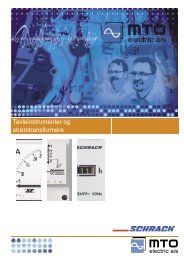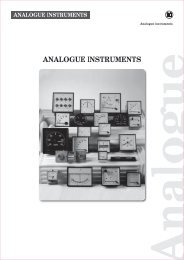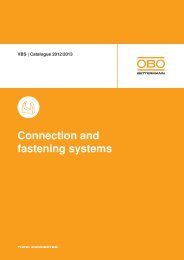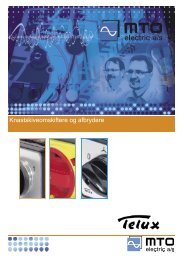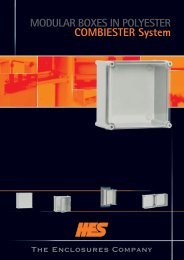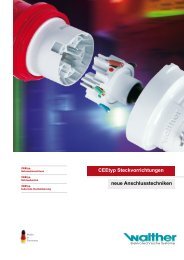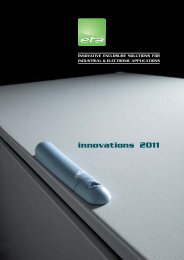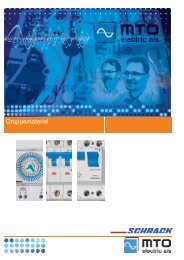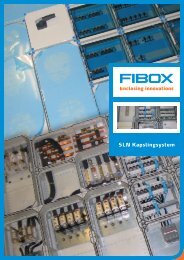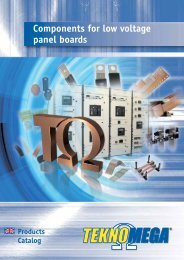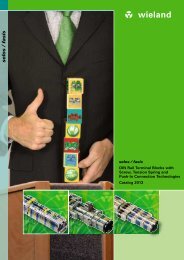Power distribution boxes - MTO electric A/S
Power distribution boxes - MTO electric A/S
Power distribution boxes - MTO electric A/S
You also want an ePaper? Increase the reach of your titles
YUMPU automatically turns print PDFs into web optimized ePapers that Google loves.
Rubber, our material/Notes on installation<br />
Installation notes for your <strong>electric</strong>al planning<br />
Natural rubber and how it is extracted<br />
Natural rubber is extracted by tapping trees (Hevea brasilienis) to obtain a<br />
pale sap (latex milk). The tree reaches up to 20 m in height and requires a<br />
hot, damp climate. It belongs to the spurge family of plants. The production<br />
centres are grouped along the equator and consist of plantation rubber<br />
and wild rubber. The sap tapped from the tree is made to coagulate in<br />
raw rubber factories by adding vinegar or formic acid, then squeezed out<br />
and dried. This is carried out using fumigators, and makes the material,<br />
obtained by the rolling mill, durable. The material is packed into balls and<br />
sent off in this form for further processing. The natural rubber obtained<br />
in this way now makes up only around 30 % of total rubber production.<br />
Difference between india rubber/normal rubber<br />
India rubber and india rubber mixtures are ductile materials. A material<br />
is ductile if after shaping and after removing the shaping force, it retains<br />
its new shape.<br />
Normal rubber is an elastic material. A material is elastic if after shaping<br />
and after removing the shaping force, it returns to its original shape.<br />
The solid rubber material used in Gifas production sites<br />
Gifas uses a synthetic polymer SBR india rubber as the base material;<br />
this has the optimum properties of all the possible materials. From the<br />
raw material in granular or strip form, the final shape of the workpiece<br />
is vulcanised under high pressure and at high temperature on our own<br />
machines. The vulcanisation process that occurs in the process changes<br />
the india rubber to rubber and after this stage remains elastic and stable<br />
in form, is not readily soluble and has very good thermal properties. This<br />
vulcanisation process requires considerable time and effort and is thus<br />
very costly. Only the outstanding properties of the product justify the<br />
amount of work involved.<br />
Properties<br />
Rubber has an open, cross-linked structure and does not exhibit any flow<br />
crossover, even at high temperatures. Vulcanised materials with isoprene in<br />
a cross-linked form are considerably more heat-stable than standard EDPM<br />
products. The material used by Gifas remains elastic at a temperature of<br />
up to > -45 degrees Celsius. The rubber products manufactured by Gifas<br />
are in general resistant to the acids and alkalis used in industry. Using<br />
special additives, the <strong>electric</strong>al properties such as insulation strength and<br />
creep resistance are specifically improved. This forms the starting point<br />
for countless uses in <strong>electric</strong>al engineering.<br />
Design options<br />
Technical installations are and will remain a necessary evil in architecture.<br />
These days, increasing attention is being paid to aesthetic design in public<br />
and industrial buildings. Many attractive solutions have already been realised,<br />
in the ventilation and sanitation sectors in particular. However, the<br />
<strong>electric</strong>al installation has long remained a „poor cousin“ here.<br />
Aims of colourful design in power sources<br />
• Creates a visual distinction between different power sources<br />
• Indicates the location<br />
• Architecturally pleasing design<br />
• Creative installations instead of the everyday<br />
In addition to excellent product quality, we offer matchless services. Our<br />
expert advisors are well-versed in all the latest technologies. Comprehensive<br />
bids provide a completely reliable assessment of the project. Thanks<br />
to our years of expertise and intense creative work, today we can advise on<br />
solutions that are high quality both in terms of aesthetics and technology.<br />
Technology – Design – Requirements<br />
We attend to these important details and endeavour to realise highly<br />
practical and comprehensible solutions for our customers. In addition to a<br />
compact <strong>distribution</strong> box design, we add the desired accents with colour.<br />
Large parts of the <strong>electric</strong>al installations, such as all the plug and socket<br />
combinations, switch points, etc., cannot be implemented until the final<br />
phase of a new-build. In this tight time-scale, every hour can impact the<br />
completion date in a negative way.<br />
More efficient installation<br />
Using pre-fabricated power <strong>distribution</strong> <strong>boxes</strong>, considerable amounts<br />
of time-consuming work are rendered non-critical. A further advantage<br />
is not least the simplified cable routing and the ever-present flexibility in<br />
planning work, because the detailed fittings don‘t need to be fixed until<br />
a relatively late stage.<br />
4 GIFAS-ELECTRIC GmbH · Dietrichstrasse 2 · P.O. Box · CH-9424 Rheineck



